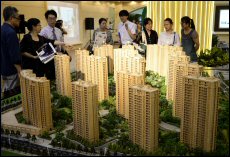
The Chinese mainland’s urbanisation policy has been spurred by empirical evidence from around the world showing that grouping populations in cities boosts production and productivity. Cities also encourage consumption, especially when it comes to nurturing a rapidly growing consumer class with rising purchasing power.
Based on figures from 30 mainland cities selected by a Hong Kong Trade Development Council (HKTDC) study, the total urban population in these cities has increased by 12 per cent, rising from 116 million in 2006 to 130 million in 2011. As a result, the sum of their industrial output and GDP increased by 107 per cent and 114 per cent respectively. With the growth of the middle-income class, the size and depth of the retail market increased swiftly across all of these cities.
New Urbanisation Model
The mainland’s urbanisation rate reached 52.6 per cent in 2012, which created a rapid expansion of its larger cities, notably Beijing, Shanghai, Chongqing, Guangzhou, Wuhan, Nanjing, Chengdu and Shenyang. According to the 12th Five-Year Plan, the urbanisation rate is expected to rise by four per cent by 2015, meaning that every year, more than 10 million rural residents will relocate to the cities.
To promote the healthy development of urbanisation in the medium- to long-term, the National Development and Reform Commission (NDRC) will publish a new urbanisation plan later this year. It is understood that future mainland urbanisation initiatives will focus more on the development of lower-tier cities to avoid overburdening first-tier cities. The new proposals will also introduce institutional reforms to help rural migrants integrate into a city environment. The household registration system, for example, is expected to be revised to allow migrant families better access to education and medical services. The eligibility criteria for residency is also expected to be relaxed, particularly in smaller cities.
The new urbanisation plan is expected to allocate government resources, including medical, education, utilities and other services, to cities according to their population size rather than their administrative status. Under this new system, cities and townships with a population below 500,000 would be regarded as small cities; those with between 500,000 and one million would be medium-sized cities; those with one to five million residents would be classified as large cities and those above the five million mark, mega cities.
Should this change be implemented, the mainland will have 12 mega cities, 115 large cities, 108 medium cities and 53 small cities at the prefecture level. As an additional consequence, a number of county-level cities that do not have a sufficiently large population may have to merge with others to reach the required threshold for small and medium cities. Several towns, including Humen, Changan and Xiaolan in the Pearl River Delta (PRD), with a population size in excess of 500,000, will be re-classified as small cities, entitling them to increased infrastructure and social services investment. The ultimate goal of these changes is to hasten development and raise the number of small and medium cities, while increasing their appeal to rural migrants and raising their capacity to handle an expanded population. In other words, the rapid and sustained growth of the second-, third- and fourth-tier cities has now been made a strategic governmental priority across the mainland.
Integrated City Clusters

To promote the coordinated development of different regions, more than 20 city clusters, containing varying hierarchies of cities, will be built across the country. Under the proposals, efforts will be made to boost the economic linkages and complementary functions of cities in the clusters. The goal is to enhance the quality of the urbanisation programme and strengthen the economic halo effect of the hub city, accelerating both industrial development and job creation in the smaller cities.
In part, these measures will come from investment in nationwide, multi-modal transportation networks, including highways, railways and air-links, all aimed at increasing travel efficiency among different city clusters and within any given region. Priority will also be given to infrastructure development, particularly with regards to electricity and water supplies, telecommunication systems and environmental conservation projects. These initiatives are to be fully coordinated to ensure the orderly development of many of the mainland’s integrated city clusters.
Improved transportation links have already seen a number of PRD manufacturing firms relocate (or announce plans to relocate) their production facilities to other parts of Guangdong Province or even further afield, including Jiangxi, Hunan and Guangxi that lie adjacent to Guangdong. This process has been mirrored in the Yangtze River Delta (YRD) region, with a number of businesses now looking to expand into neighbouring and less developed sites to stay competitive.
In most cases, these new satellite production bases maintain close ties with their PRD and YRD headquarters, while benefiting from the advantages of complementary activities. Many of these satellite manufacturing bases, for instance, depend on sources in Guangzhou or Shanghai to supply the production inputs or supporting services they require to maintain the required levels of output.
Newly-affluent Consumers

While cities are interdependent in the larger urban clusters, certain social-economic processes, such as shopping, remain local in focus. A recent HKTDC survey of mainland middle-class consumers, for instance, found that 67 per cent of respondents believed that there was no need for them to visit hub cities for their shopping and a variety of other purchasing requirements.
According to economic geography theory, it is highly desirable to create a hierarchy of cities where the size and variety of goods and services provided are perfectly correlated. Underpinning this theory is the assumption that all goods and services have a fixed geographical domain beyond which consumers are unwilling to travel. In the case of the mainland, one effect of recent urbanisation has been a rapid growth in the number of new commercial districts located in the suburbs of the large and mega cities. This has been matched by a substantial development in the retail amenities of the small and medium cities as the needs of the local consumer base has grown.
Changzhou, a third-tier city in the YRD, typifies these changes. As a result of the city’s economic and population growth, it now has a substantial local pool of consumers who are affluent enough to merit the presence of a wide variety of products and services, including those of a specialised or upmarket nature. Changzhou has made substantial efforts to ensure that it can meet rising consumer demand. In recent years, it has built a number of new department stores and shopping centres, ensuring that new brands have been introduced to the local market as part of an overall upgrade to the city’s retail sector. As a result, 66 per cent of the Changzhou respondents surveyed say there is no need for them to travel to tier-one or tier-two cities for shopping purposes.
Changzhou is, by no means, an exception in terms of the progress of the mainland’s urbanisation programme. The retail and commercial development of the second- and third-tier cities has been described by some as a move toward first-tier status. While this may be a slight exaggeration, it contains a kernel of truth and vividly encapsulates the rapid and continuing development of many smaller cities.
Second- and third-tier cities have been making significant advances in upgrading their infrastructure and jump-starting higher consumption levels in recent years. It seems inevitable that even smaller cities will eventually follow the same path. Companies that are serious about targeting the mainland market would be well-advised to revisit their retail strategies and ensure that their forward strategies factor in affluent consumers in smaller cities.
For more on the Chinese mainland market, please see the September issue of the HKTDC Trade Quarterly.